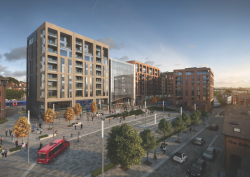 Abraham Lincoln
If given the truth, the people can be depended upon to meet any national crisis...
Abraham Lincoln
If given the truth, the people can be depended upon to meet any national crisis...
 Guildford news...
for Guildford people, brought to you by Guildford reporters - Guildford's own news service
Guildford news...
for Guildford people, brought to you by Guildford reporters - Guildford's own news service
Letter: Solum Planning Inquiry Shows Need For More Collaboration
Published on: 21 Nov, 2017
Updated on: 21 Nov, 2017
hon alderman and former Mayor of Guildford
Now that the ten-day inquiry is at an end, as a non-participant, but one who has been involved in many Guildford developments, directly or indirectly since 1970 (eg Wey Flood Control, MEPC Friary, Westfields, Surrey HQ), I would like to reflect on what we can learn from it.
I have to confess that I start with a prejudice against such a massive ten-storey glass and concrete wall. It would be totally out of character with the location and town centre, offer few community benefits, scarcely any rail improvements and would compound traffic problems.
Guildford Borough Council (GBC) opposed it and engaged an excellent QC who made, as one would expect, a strong case against. I would like to recognise the support the council has had from the Guildford Society (GSoc), represented by its Chairman Julian Lyon, and the Guildford Vision Group (GVG), represented by its Chairman John Rigg. Both societies brought a huge amount of experience and expertise supporting the Council case.
They stressed that this massive block, “30% longer than the Palace of Westminster’s frontage onto the Thames” was the largest ever proposed for Guildford, would compound traffic congestion (creating more pollution and causing more accidents) make very few improvements to the railway station, provide little affordable housing and block options for alternative road layouts.
Rarely can such a professional and relevant case have been put to a planning inspector. I would like to publicly record my thanks, which I hope will be a shared by others, for the huge voluntary effort that GSoc and GVG, and their professional colleagues have put into this presentation. Surely we all are opposed to turning Guildford – a historic gap town with serious congestion problems – into another Croydon or Woking?
The case for the development by Solum largely rested on the fact that there was no approved existing plan, that there were no policies to stop it, and that in order to meet government housing targets the project should be approved – although in practice it was most unlikely to achieve government targets.
What can we learn from this experience?
1. There is a huge pool of professional expertise which the council could use to supplement its own expertise – and there should be more collaboration.
2. The council needs to review its policy on building heights which are currently extremely vague (stipulating only that the view from Guildford Castle to the cathedral should not be affected). There should be a specific height restriction in the town centre which respects the scale and character of the town. These should be incorporated into the new architectural guidelines being finalised.
3. The council needs to strengthen its capacity to assess financial viability. Solum was able to claim, implausibly, that they could not afford to offer many community benefits (e.g. affordable housing).
One hopes that the council, GVG and GSoc will collaborate more closely in future in order to achieve a sustainable economic and social development plan and to meet housing targets.

"Found any?" - "Nope, it all looks green to me!" (See Opinion: The Future is Congested, the Future is Grey)
www.abbotshospital.org/news/">





Recent Articles
- Latest Evidence in Sara Sharif Trial
- Ash’s New Road Bridge Is Named – and November 23rd Is Opening Day
- Class A in Underwear Leads to Jail Sentence
- Historical Almshouse Charity Celebrates Guildford in Bloom Victory
- Notice: Shalford Renewable Showcase – November 16
- Firework Fiesta: Guildford Lions Club Announces Extra Attractions
- Come and Meet the Flower Fairies at Watts Gallery
- Updated: Royal Mail Public Counter in Woodbridge Meadows to Close, Says Staff Member
- Letter: New Developments Should Benefit Local People
- Open Letter to Jeremy Hunt, MP: Ash’s Healthcare Concerns


Search in Site
Media Gallery
Dragon Interview: Local Artist Leaves Her Mark At One of England’s Most Historic Buildings
January 21, 2023 / No Comment / Read MoreDragon Interview: Lib Dem Planning Chair: ‘Current Policy Doesn’t Work for Local People’
January 19, 2023 / No Comment / Read MoreA3 Tunnel in Guildford ‘Necessary’ for New Homes, Says Guildford’s MP
January 10, 2023 / No Comment / Read More‘Madness’ for London Road Scheme to Go Ahead Against ‘Huge Opposition’, Says SCC Leader
January 6, 2023 / No Comment / Read MoreCouncillor’s Son Starts Campaign for More Consultation on North Street Plan
December 30, 2022 / No Comment / Read MoreCounty Council Climbs Down Over London Road Works – Further ‘Engagement’ Period Announced
December 14, 2022 / No Comment / Read MoreDragon Interview: GBC Reaction to the Government’s Expected Decision to Relax Housing Targets
December 7, 2022 / No Comment / Read MoreHow Can Our Town Centre Businesses Recover? Watch the Shop Front Debate
May 18, 2020 / No Comment / Read More








Recent Comments